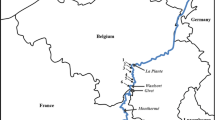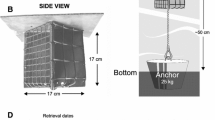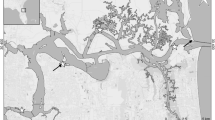Abstract
The effects of invasive macrophytes, water level fluctuations and predation on freshwater unionids Pyganodon grandis and Utterbackia imbecillis were studied in three small impoundments in Northeastern Texas in 2003–2005. Mussel density was sampled with quadrats. Mortality, associated with the water level fluctuations and predation, was estimated by collecting dead shells on the shore at about two month intervals. In two ponds, horizontal distribution of unionids was limited by dense beds of invasive and noxious macrophytes (mainly Eurasian watermilfoil Myriophyllum spicatum and American lotus Nelumbo lutea): mussel densities were significantly lower in these macrophyte beds (P < 0.001). In the third pond with the lowest density of macrophytes (stonewort Chara sp.), unionids were distributed more evenly, and the average unionid biomass was the highest among all ponds studied. Vertical distribution of unionids in all ponds was likely limited by low oxygen at depth >2 m. The total amount of shells found on the shore per year varied from 0.1% to 28% of the total population in the pond and was negatively correlated with water level (r = −0.72 to −0.81, P < 0.005). Mammalian predators consumed up to 19% of the total unionid population and predation was facilitated by water level fluctuations.




Similar content being viewed by others
References
Anthony, J. L., D. H. Kesler, W. L. Downing & J. A. Downing, 2001. Length-specific growth rate in freshwater mussels (Bivalvia: Unionidae): extreme longevity or generalized growth season? Freshwater Biology 46: 1349–1359.
Bauer, G., 2000. Factors affecting naiad occurrence and abundance. In Bauer, G. & K. Wachter (eds), Ecology and Evolution of the Freshwater Mussels Unionoidea, Ecological Studies, Vol. 145. Springler-Verlag, Berlin, Heidelberg, New York, 155–162.
Baxter, R. M. 1977. Environmental effects of dams and impoundments. Annual Review of Ecology and Systematics 8: 255–283.
Blinn, D. W., J. P. Shannon, L. E. Stevens & J. P. Carder, 1995. Consequences of fluctuating discharge for lotic communities. Journal of the North American Benthological Society 14: 233–248.
Bogan, A. E., 1993. Freshwater bivalve extinctions (Mollusca: Unionoida): a search for causes. American Zoologist 33: 599–609.
Burlakova, L. E., A. Y. Karatayev & D. K. Padilla, 2000. The impact of Dreissena polymorpha (Pallas) invasion on unionid bivalves. International Review of Hydrobiology 85: 529–541.
Byrne, R. A. & R. F. McMahon, 1994. Behavioral and physiological responses to emersion in fresh water bivalves. American Zoologist 34: 194–204.
Caraco, N. F. & J. Cole, 2002. Contrasting impacts of a native and alien macrophyte on dissolved oxygen in a large river. Ecological Applications 12: 1496–1504.
Convey, L. E., J. M. Hanson & W. M. Mackay, 1989. Size-selective predation on unionid clams by muskrats. Journal of Wildlife Management 53: 654–657.
Cvancara, A. M., 1972. Lake mussel distribution as determined with SCUBA. Ecology 53: 154–157.
Downing, J. A., H. Van Leeuwen & L. A. Di Paolo, 2000. Substratum patch selection in the lacustrine mussels Elliptio complanata and Pyganodon grandis grandis. Freshwater Biology 44: 641–648.
Elliott, J. M., 1977. Some Methods for the Statistical Analysis of Samples of Benthic Invertebrates. Freshwater Biological Association, Ambleside, Cumbria, UK.
Ellis, M. M., 1936. Erosion silt as a factor in aquatic environments. Ecology 17: 29–42.
Freeman, G. H. & J. H. Halton, 1951. Note on an exact treatment of contingency, goodness of fit and other problems of significance. Biometrika 38: 141–149.
Ghent, A. W., R. Singer & L. Johnson-Singer, 1978. Depth distributions determined with SCUBA, and associated studies of the freshwater clams Elliptio complanata and Pyganodon grandis in Lake Bernard, Ontario. Canadian Journal of Zoology 56: 1654–1663.
Green, R. H. 1980. Role of a unionid clam population in the calcium budget of a small arctic lake. Canadian Journal of Fisheries and Aquatic Sciences 37: 219–224.
Hall, T. F. & W. T. Penfound, 1944. The biology of the American lotus, Nelumbo lutea (Willd.) Pers. American Midland Naturalist 31: 744–758.
Hanson, J. M., W. C. Mackay & E. E. Prepas, 1988. The effects of water depth and density on the growth of a unionid clam. Freshwater Biology 19: 345–355.
Hanson, J. M., W. C. Mackay & E. E. Prepas, 1989. Effect of size-selective predation by muskrats (Ondatra zibethicus) on a population of unionid clams (Anodonta grandis simpsoniana). Journal of Animal Ecology 58: 15–28.
Halstead, B. G. & J. C. Tash, 1982. Unusual diel pHs in water as related to aquatic vegetation. Hydrobiologia 96: 217–224.
Havel, J. E., C. E. Lee & J. M. Vander Zanden, 2005. Do reservoirs facilitate invasions into landscapes? BioScience 55: 518–525.
Howells, R. G., C. M. Mather & J. A. M. Bergmann, 2000. Impacts of dewatering and cold on freshwater mussels (Unionidae) in B. A. Steinhagen Reservoir, Texas. Texas Journal of Science 52: 93–104.
Huehner, M. K., 1987. Field and laboratory determination of substrate preferences of unionid mussels. Ohio Journal of Science, 87: 29–32.
Karatayev, A. Y., L. E. Burlakova, T. Kesterton & D. K. Padilla, 2003. Dominance of the Asiatic clam, Corbicula fluminea (Müller) in the benthic community of a reservoir. Journal of Shellfish Research 22: 487–493.
Krebs, C. J., 1999. Ecological Methodology (2nd edn.). Addison Wesley Longman, Inc., Reading, MA.
Manly, B., 1992. The Design and Analysis of Research Studies. Cambridge University Press.
McMahon, R. F. & A. E. Bogan, 2001. Mollusca: Bivalvia. In Thorp, J. H. & A. P. Covich (eds), Ecology and Classification of North American Freshwater Invertebrates (2nd edn.). Academic Press, Inc., 331–430.
Miller, A. C., L. Rhodes & R. Tipit, 1984. Changes in the naiad fauna of the Cumberland River below Lake Cumberland in Central Kentucky. Nautilus 98: 107–110.
Mohseni, O., H. G. Stefan, D. Wright & G. J. Johnson, 2001. Dissolved oxygen depletion in a small deep lake with a large littoral zone. Lake and Reservoir Management 17: 288–298.
Myers, J. H., 1978. Selecting a measure of dispersion. Environmental Entomology 7: 619–621.
Negus, C. L., 1966. A quantitative study of growth and production of unionid mussels in the River Thames at Reading. Journal of Animal Ecology 35: 513–532.
Neves, R. J. & M. C. Odom, 1989. Muskrat predation on endangered freshwater mussels in Virginia. Journal of Wildlife Management 53: 934–941.
Ricciardi, A., F. G. Whoriskey & J. B. Rasmussen, 1996. Impact of the Dreissena invasion on native unionid bivalves in the upper St. Lawrence River. Canadian Journal of Fisheries and Aquatic Sciences 53: 1434–1444.
Rice, W. R., 1989. Analyzing tables of statistical tests. Evolution 43: 223–225.
Richardson, S. M., M. J. Hanson & A. Locke, 2002. Effects of impoundment and water-level fluctuations on macrophyte and macroinvertebrate communities of a dammed tidal river. Aquatic Ecology 36: 493–510.
Richter, B. D., D. P. Braun, M. A. Mendelson & L. L. Master, 1997. Threats to imperiled freshwater fauna. Conservation Biology 11: 1081–1093.
Rogers, J. A., 1981. The American lotus – Nelumbo lutea (Willd.) Pers. Aquatics 3: 4–8.
Samad, F. & J. G. Stanley, 1986. Loss of freshwater shellfish after water drawdown in Lake Sebasticook, Maine. Journal of Freshwater Ecology 3: 519–523.
Sebestyen, O., 1937. Colonization of two new fauna-elements of Pontus-origin (Dreissena polymorpha Pall. and Corophium curvispinum G. O. Sars forma devium Wundsch) in Lake Balaton. Proceedings. International Association of Theoretical and Applied Limnology 8: 169–182.
Schloesser, D. W., T. F. Nalepa & G. L. Mackie, 1996. Zebra mussel infestation of unionid bivalves (Unionidae) in North America. American Zoologist 36: 300–310.
Steyermark, J. A., 1963. Flora of Missouri. The Iowa State University Press, Ames, Iowa.
Stone, N. M., R. Earll, A. Hodgson, J. G. Mather, J. Parker & F. R. Woodward, 1982. The distributions of three sympatric mussel species (Bivalvia: Unionidae) in budworth Mere, Cheshire. Journal of Molluscan Studies 48: 266–274.
Strayer, D. L., 1999. Effects of alien species on freshwater mollusks in North America. Journal of the North American Benthological Society 18: 74–98.
Strayer, D. L., J. A. Downing, W. R. Haag, T. L. King, J. B. Layzer, T. J. Newton & S. J. Nichols, 2004. Changing perspectives on pearly mussels, North America’s most imperiled animals. BioScience 54: 429–439.
Toweill, D. E., 1974. Winter food habits of river otters in western Oregon. Journal of Wildlife Management 38: 107–111.
Tyrrell, M. & D. J. Hornbach, 1998. Selective small mammal predation on freshwater mussels in two Minnesota rivers. Journal of the North American Benthological Society 17: 301–310.
Unmuth, J. M. L., R. A. Lillie, D. S. Dieikosen & D. W. Marshall, 2000. Influence of dense growth of Eurasian water-milfoil on lake water temperature and dissolved oxygen. Journal of Freshwater Ecology 15: 497–503.
Vaughn, C. C. & C. M. Taylor, 1999. Impoundments and the decline of freshwater mussels: a case study of an extinction gradient. Conservation Biology 13: 912–920.
Vaughn, C. C. & C. C. Hakenkamp, 2001. The functional role of burrowing bivalves in freshwater ecosysytems. Freshwater Biology 46: 1431–1446.
Watters, T. G., 2000. Freshwater mussels and water quality: a review of the effects of hydrologic and instream habitat alterations. Proceedings of the First Freshwater Mollusk Conservation Society Symposium. Ohio Biological Survey.
Williams, J. D., M. L. Warren Jr., K. S. Cummings, J. L. Harris & R. J. Neves, 1993. Conservation status of freshwater mussels of the United States and Canada. Fisheries (Bethesda) 18: 6–22.
White, D. S., 1979. The effect of lake-level fluctuation on Corbicula and other pelecypods in Lake Texoma, Texas and Oklahoma. In Britton, J. C. (ed.), Proceedings, First International Corbicula Symposium, Texas Christian University Research Foundation, Forth Worth, Texas, 82–88.
Zar J. H., 1996. Biostatistical Analysis (3rd edn.). Prentice Hall, Upper Saddle River, New Jersey.
Acknowledgements
The research was supported by grant # 434210 “Monitoring of Unionid Populations at Texas Army National Guard (TXARNG) Facility Camp Maxey, Lamar County, Texas” from Texas Army National Guard to AYK and LEB. We would like to thank Dmitry and Vadim Karatayev, and graduate students of the Stephen F. Austin State University (SFASU) Olga Minich and Daniel Bennett for their help during sampling. We thank Dr. James Vankley (SFASU) for identification of M. spicatum, Drs. William W. Gibson, William B. Godwin (SFASU), and reviewers for their valuable comments on the manuscript. We appreciate the help and support of Camp Maxey staff and Dr. Dawn Johnson (TXARNG) throughout the study.
Author information
Authors and Affiliations
Corresponding author
Additional information
Handling editor: K. Martens
Rights and permissions
About this article
Cite this article
Burlakova, L.E., Karatayev, A.Y. The effect of invasive macrophytes and water level fluctuations on unionids in Texas impoundments. Hydrobiologia 586, 291–302 (2007). https://doi.org/10.1007/s10750-007-0699-1
Received:
Revised:
Accepted:
Published:
Issue Date:
DOI: https://doi.org/10.1007/s10750-007-0699-1




